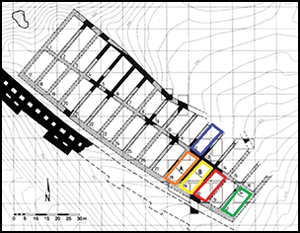Crossref Citations
This article has been cited by the following publications. This list is generated based on data provided by
Crossref.
Shin, Nami
Marston, John M.
Luke, Christina
Roosevelt, Christopher H.
and
Riehl, Simone
2021.
Agricultural practices at Bronze Age Kaymakçı, western Anatolia.
Journal of Archaeological Science: Reports,
Vol. 36,
Issue. ,
p.
102800.
Stroud, Elizabeth
Bogaard, Amy
and
Charles, Michael
2021.
A stable isotope and functional weed ecology investigation into Chalcolithic cultivation practices in Central Anatolia: Çatalhöyük, Çamlıbel Tarlası and Kuruçay.
Journal of Archaeological Science: Reports,
Vol. 38,
Issue. ,
p.
103010.
Marston, John M.
2021.
Archaeological Approaches to Agricultural Economies.
Journal of Archaeological Research,
Vol. 29,
Issue. 3,
p.
327.
Maltas, Tom
Şahoğlu, Vasif
Erkanal†, Hayat
and
Tuncel, Rıza
2022.
Prehistoric Farming Settlements in Western Anatolia.
Journal of Mediterranean Archaeology,
Vol. 34,
Issue. 2,
p.
252.
Marston, John M.
Çakırlar, Canan
Luke, Christina
Kováčik, Peter
Slim, Francesca G.
Shin, Nami
and
Roosevelt, Christopher H.
2022.
Agropastoral Economies and Land Use in Bronze Age Western Anatolia.
Environmental Archaeology,
Vol. 27,
Issue. 6,
p.
539.
Adcock, Sarah E.
2022.
Collapse, complexity, and caprines: Zooarchaeological investigations of the Hittite state and its afters.
Journal of Anthropological Archaeology,
Vol. 68,
Issue. ,
p.
101465.
Styring, Amy K.
Carmona, Chris U.
Isaakidou, Valasia
Karathanou, Angeliki
Nicholls, Geoff K.
Sarpaki, Anaya
and
Bogaard, Amy
2022.
Urban form and scale shaped the agroecology of early ‘cities’ in northern Mesopotamia, the Aegean and Central Europe.
Journal of Agrarian Change,
Vol. 22,
Issue. 4,
p.
831.
Erb-Satullo, Nathaniel L.
and
Jachvliani, Dimitri
2022.
Fortified Communities in the South Caucasus: Insights from Mtsvane Gora and Dmanisis Gora.
Journal of Field Archaeology,
Vol. 47,
Issue. 5,
p.
305.
Casa, Romina Della
2022.
Encountering Ancient Environments.
Near Eastern Archaeology,
Vol. 85,
Issue. 4,
p.
258.
Maltas, Tom
Şahoğlu, Vasıf
Erkanal, Hayat
and
Tuncel, Rıza
2022.
From horticulture to agriculture: New data on farming practices in Late Chalcolithic western Anatolia.
Journal of Archaeological Science: Reports,
Vol. 43,
Issue. ,
p.
103482.
Castellano, Lorenzo
2023.
Grapes and Wine in pre-Roman Anatolia: Evidence of Large-Scale Viticulture from Southern Cappadocia, the Land of the Storm-God of the Vineyard.
Journal of Near Eastern Studies,
Vol. 82,
Issue. 2,
p.
171.
Lodwick, Lisa
2023.
Cultivating Villa Economies: Archaeobotanical and Isotopic Evidence for Iron Age to Roman Agricultural Practices on the Chalk Downlands of Southern Britain.
European Journal of Archaeology,
Vol. 26,
Issue. 4,
p.
445.
Pucci, Marina
2023.
Administrative Practices and Political Control in Anatolian and Syro-Anatolian Polities in the 2nd and 1st Millennium BCE.
Vol. 13,
Issue. ,
p.
161.
Manning, Sturt W.
Kocik, Cindy
Lorentzen, Brita
and
Sparks, Jed P.
2023.
Severe multi-year drought coincident with Hittite collapse around 1198–1196 bc.
Nature,
Vol. 614,
Issue. 7949,
p.
719.
Marston, John M.
and
Vaiglova, Petra
2024.
Chapter 7. Mapping land use with integrated environmental archaeological datasets.
Archaeological Papers of the American Anthropological Association,
Vol. 35,
Issue. 1,
p.
73.
Irvine, Benjamin
Shin, Nami
Luke, Christina
and
Roosevelt, Christopher H.
2024.
Stable carbon isotope (δ13C) analysis of archaeobotanical remains from Bronze Age Kaymakçı (western Anatolia) to investigate crop management.
Vegetation History and Archaeobotany,
Vol. 33,
Issue. 2,
p.
289.
Treasure, Edward R.
Gröcke, Darren R.
Lester, Jonathan J.
Bishop, Rosie R.
Jackson, Samuel E.
and
Church, Mike J.
2024.
Further investigation into the impact of manuring on stable carbon (δ13C) and nitrogen isotope (δ15N) values in pulses: a four-year experiment examining Celtic bean (Vicia faba).
Archaeological and Anthropological Sciences,
Vol. 16,
Issue. 8,
Stroud, Elizabeth
Charles, Michael
Jones, Glynis
Hodgson, John G.
and
Bogaard, Amy
2024.
Seeing the fields through the weeds: introducing the WeedEco R package for comparing past and present arable farming systems using functional weed ecology.
Vegetation History and Archaeobotany,
Vol. 33,
Issue. 4,
p.
475.
Irvine, Benjamin
Luke, Christina
Çakırlar, Canan
Kaner, Tunç
Özbal, Rana
Fındıklar, Şengül
and
Roosevelt, Christopher H
2025.
Stable isotope analysis of faunal remains from Bronze Age Kaymakçı, Western Anatolia.
The Holocene,
Vol. 35,
Issue. 3,
p.
223.
Morgan, Alistair W.
Paine, Alice R.
Koç, Koray
Haldon, John
Hofmeister, Elisa
Cheng, Hai
Tüysüz, Okan
Matter, Albert
Edwards, Lawrence R.
Haghipour, Negar
Hajdas, Irka
and
Fleitmann, Dominik
2025.
Societal responses to cold-season rainfall variability: a speleothem perspective on Byzantine and Hittite climate interactions in Late Holocene Türkiye and southeast Europe.
Quaternary Science Reviews,
Vol. 359,
Issue. ,
p.
109365.


